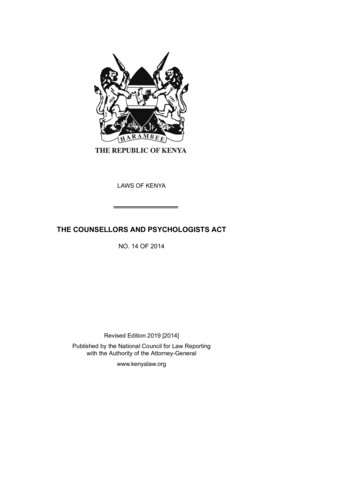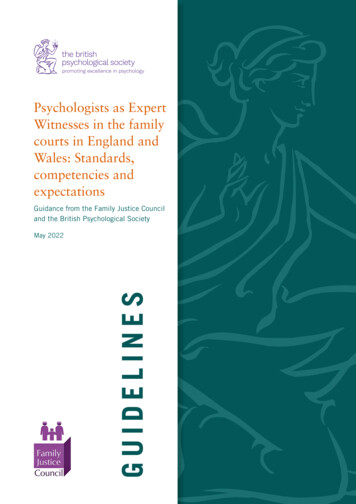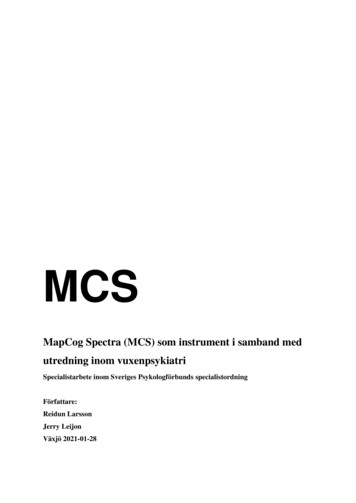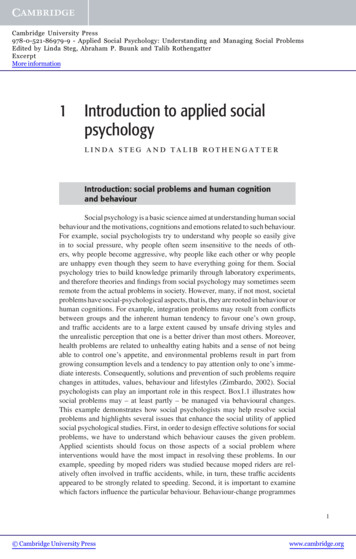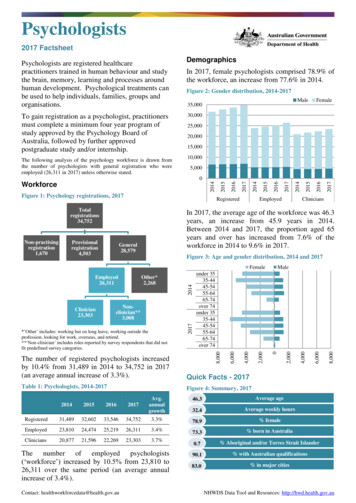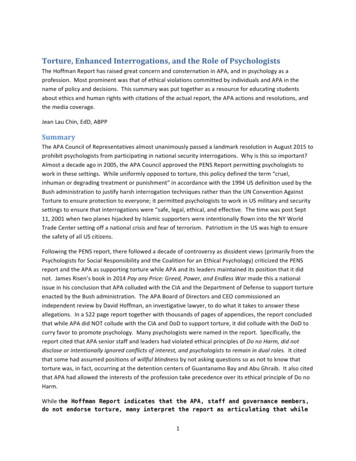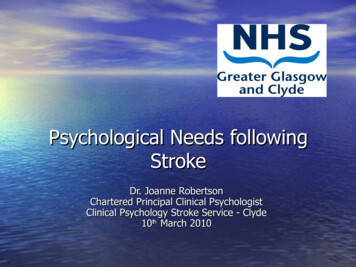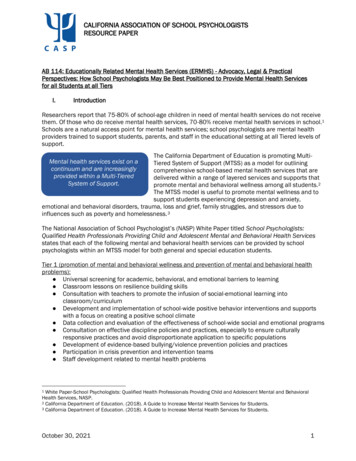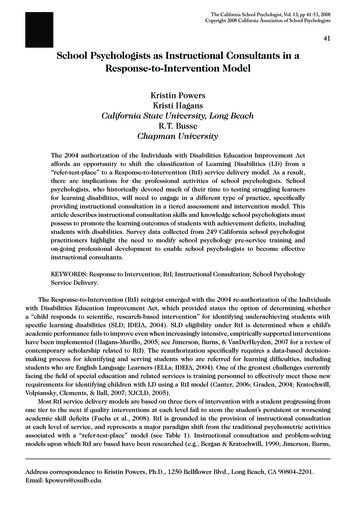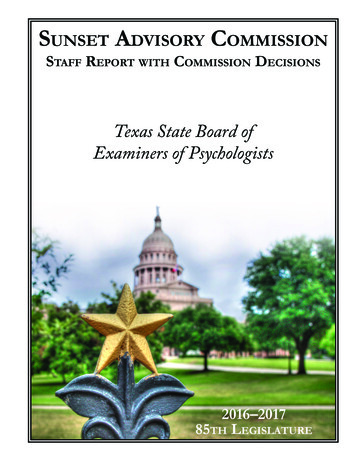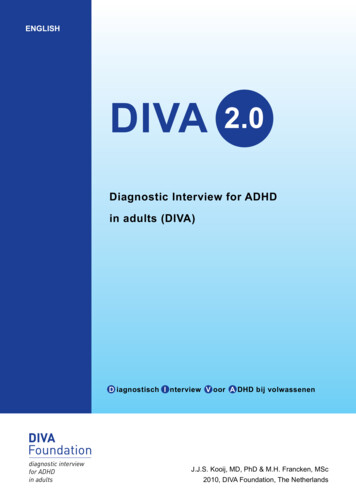
Transcription
ENGLISHDIVA2.0Diagnostic Interview for ADHDin adults (DIVA)D iagnostisch I nterview V oor A DHD bij volwassenendiagnostic interviewfor ADHDin adultsJ.J.S. Kooij, MD, PhD & M.H. Francken, MSc2010, DIVA Foundation, The Netherlands
ColophonIntroductionThe Diagnostic Interview forADHD in adults (DIVA) is apublication of the DIVAFoundation, The Hague,The Netherlands, August2010. The original Englishtranslation by VertaalbureauBoot was supported byJanssen-Cilag B.V. Backtranslation into Dutch bySietske Helder. Revison bydr. J.J.S. Kooij, DIVAFoundation and Prof. PhilipAsherson, Institute ofPsychiatry, London.According to the DSM-IV, ascertaining the diagnosis of ADHD in adultsinvolves determining the presence of ADHD symptoms during both childhoodand adulthood.Reprinted with permissionfrom the Diagnostic andStatistical Manual of MentalDisorders, Text Revision,Fourth Edition (Copyright2000). American PsychiatricAssociation.The Diagnostic Interview for ADHD in Adults (DIVA)This publication has beenput together with care.However, over the course oftime, parts of this publicationmight change. For thatreason, no rights may bederived from this publication. For more informationand future updates of theDIVA please visitwww.divacenter.eu.The main requirements for the diagnosis are that the onset of ADHD symptoms occurred during childhood and that this was followed by a lifelongpersistence of the characteristic symptoms to the time of the current evaluation. The symptoms need to be associated with significant clinical or psychosocial impairments that affect the individual in two or more life situations1.Because ADHD in adults is a lifelong condition that starts in childhood, it isnecessary to evaluate the symptoms, course and level of associated impairment in childhood, using a retrospective interview for childhood behaviours.Whenever possible the information should be gathered from the patient andsupplemented by information from informants that knew the person as a child(usually parents or close relatives)2.The DIVA is based on the DSM-IV criteria and is the first structured Dutchinterview for ADHD in adults. The DIVA has been developed by J.J.S. Kooijand M.H. Francken and is the successor of the earlier Semi-StructuredInterview for ADHD in adults2,3.In order to simplify the evaluation of each of the 18 symptom criteria forADHD, in childhood and adulthood, the interview provides a list of concreteand realistic examples, for both current and retrospective (childhood) behaviour. The examples are based on the common descriptions provided by adultpatients in clinical practice. Examples are also provided of the types ofimpairments that are commonly associated with the symptoms in five areas ofeveryday life: work and education; relationships and family life; social contacts; free time and hobbies; self-confidence and self-image.Whenever possible the DIVA should be completed with adults in the presenceof a partner and/or family member, to enable retrospective and collateralinformation to be ascertained at the same time. The DIVA usually takesaround one and a half hours to complete.The DIVA only asks about the core symptoms of ADHD required to make theDSM-IV diagnosis of ADHD, and does not ask about other co-occurringpsychiatric symptoms, syndromes or disorders. However comorbidity iscommonly seen in both children and adults with ADHD, in around 75% ofcases. For this reason, it is important to complete a general psychiatricassessment to enquire about commonly co-occurring symptoms, syndromesand disorders. The most common mental health problems that accompanyADHD include anxiety, depression, bipolar disorder, substance abuse disorders and addiction, sleep problems and personality disorders, and all theseshould be investigated. This is needed to understand the full range of symptoms experienced by the individual with ADHD; and also for the differentialdiagnosis, to exclude other major psychiatric disorders as the primary causeof ‘ADHD symptoms’ in adults2.2DIVA 2.0 Diagnostic Interview for ADHD in adults
Instructions for performing the DIVAThe DIVA is divided into three parts that are each appliedto both childhood and adulthood:nThe criteria for Attention Deficit (A1)nThe criteria for Hyperactivity-Impulsivity (A2)n The Age of Onset and Impairment accounted for byADHD symptomsStart with the first set of DSM-IV criteria for attention deficit(A1), followed by the second set of criteria for hyperactivity/impulsivity (A2). Ask about each of the 18 criteria inturn. For each item take the following approach:First ask about adulthood (symptoms present in the last6-months or more) and then ask about the same symptomin childhood (symptoms between the ages of 5 to 12years)4-6. Read each question fully and ask the personbeing interviewed whether they recognise this problemand to provide examples. Patients will often give the sameexamples as those provided in the DIVA, which can thenbe ticked off as present. If they do not recognise thesymptoms or you are not sure if their response is specificto the item in question, then use the examples, askingabout each example in turn. For a problem behaviour orsymptom to be scored as present, the problem shouldoccur more frequently or at a more severe level than isusual in an age and IQ matched peer group, or to beclosely associated with impairments. Tick off each of theexamples that are described by the patient. If alternativeexamples that fit the criteria are given, make a note ofthese under “other”. To score an item as present it is notnecessary to score all the examples as present, rather theaim is for the investigator to obtain a clear picture of thepresence or absence of each criterion.For each criterion, ask whether the partner or familymember agrees with this or can give further examples ofproblems that relate to each item. As a rule, the partnerwould report on adulthood and the family member (usuallyparent or older relative) on childhood. The clinician has touse clinical judgement in order to determine the mostaccurate answer. If the answers conflict with one another,the rule of thumb is that the patient is usually the bestinformant7.The information received from the partner and family ismainly intended to supplement the information obtainedfrom the patient and to obtain an accurate account of bothcurrent and childhood behaviour; the informant informationis particularly useful for childhood since many patientshave difficulty recalling their own behaviour retrospectively. Many people have a good recall for behaviour fromDIVA 2.0 Diagnostic Interview for ADHD in adultsaround the age of 10-12 years of age, but have difficultyfor the pre-school years.For each criterion, the researcher should make a decisionabout the presence or absence in both stages of life,taking into account the information from all the partiesinvolved. If collateral information cannot be obtained, thediagnosis should be based on the patient’s recall alone. Ifschool reports are available, these can help to give anidea of the symptoms that were noticed in the classroomduring childhood and can be used to support the diagnosis. Symptoms are considered to be clinically relevant ifthey occurred to a more severe degree and/or morefrequently than in the peer group or if they were impairingto the individual.Age of onset and impairmentThe third section on Age of Onset and Impairment accounted for by the symptoms is an essential part of thediagnostic criteria. Find out whether the patient has alwayshad the symptoms and, if so, whether any symptoms werepresent before 7-years of age. If the symptoms did notcommence till later in life, record the age of onset.Then ask about the examples for the different situations inwhich impairment can occur, first in adulthood then inchildhood. Place a tick next to the examples that thepatient recognises and indicate whether the impairment isreported for two or more domains of functioning. For thedisorder to be present, it should cause impairment in atleast two situations, such as work and education; relationships and family life; social contacts; free time andhobbies; self-confidence and self-image, and be at leastmoderately impairing.Summary of symptomsIn the Summary of Symptoms of Attention Deficit (A) andHyperactivity-Impulsivity (HI), indicate which of the18 symptom criteria are present in both stages of life; andsum the number of criteria for inattention and hyperactivity/impulsivity separately.Finally, indicate on the Score Form whether six or morecriteria are scored for each of the symptom domains ofAttention Deficit (A) and Hyperactivity-Impulsivity (HI). Foreach domain, indicate whether there was evidence of alifelong persistent course for the symptoms, whether thesymptoms were associated with impairment, whetherimpairment occurred in at least two situations, andwhether the symptoms might be better explained byanother psychiatric disorder. Indicate the degree to which3
the collateral information, and if applicable school reports,support the diagnosis. Finally, conclude whether thediagnosis of ADHD can be made and which subtype (withDSM-IV code) applies.Explanation to be given beforehand to the patientThis interview will be used to ask about the presence ofADHD symptoms that you experienced during yourchildhood and adulthood. The questions are based on theofficial criteria for ADHD in the DSM-IV. For each questionI will ask you whether you recognise the problem. To helpyou during the interview I will provide some examples ofeach symptom, that describe the way that children andadults often experience difficulties related to each of thesymptoms of ADHD. First of all, you will be asked thequestions, then your partner and family members (ifpresent) will be asked the same questions. Your partnerwill most likely have known you only since adulthood andwill be asked questions about the period of your life thathe or she knew you for; your family will have a better ideaof your behaviour during childhood. Both stages of yourlife need to be investigated in order to be able to establishthe diagnosis of ADHD.References1. American Psychiatric Association (APA):Diagnostic and Statistical Manual of MentalDisorders, Text Revision, Fourth Edition.Washington DC, 2000.2. Diagnostic Interview for ADHD in Adults 2.0(DIVA 2.0), in: Kooij, JJS. Adult ADHD. Diagnostic assessment and treatment. Pearson Assessment and Information BV, Amsterdam, 2010.3. Kooij JJS, Francken MH: Diagnostisch InterviewVoor ADHD (DIVA) bij volwassenen. Onlineavailable at www.kenniscentrumadhdbijvolwassenen.nl, 2007 and published in English inreference 2.4. Applegate B, Lahey BB, Hart EL, Biederman J,Hynd GW, Barkley RA, Ollendick T, Frick PJ,Greenhill L, McBurnett K, Newcorn JH, KerdykL, Garfinkel B, Waldman I, Shaffer D: Validity ofthe age-of-onset criterion for ADHD: a reportfrom the DSM-IV field trials. J Am Acad ChildAdolesc Psychiatry 1997; 36(9):1211-215. Barkley RA, Biederman J: Toward a broaderdefinition of the age-of-onset criterion forattention-deficit hyperactivity disorder. J AmAcad Child Adolesc Psychiatry 1997;36(9):1204-106. Faraone SV, Biederman J, Spencer T, Mick E,Murray K, Petty C, Adamson JJ, MonuteauxMC: Diagnosing adult attention deficit hyperactivity disorder: are late onset and subthresholddiagnoses valid? Am J Psychiatry2006;163(10):1720-97. Kooij JJS, Boonstra AM, Willemsen-SwinkelsSHN, Bekker EM, Noord Id, Buitelaar JL:Reliability, validity, and utility of instruments forself-report and informant report regardingsymptoms of Attention-Deficit/HyperactivityDisorder (ADHD) in adult patients. J AttenDisorders 2008; 11(4):445-458Reprinted with permission from the Diagnostic andStatistical Manual of Mental Disorders, Text Revision, Fourth Edition (Copyright 2000). AmericanPsychiatric Association.4DIVA 2.0 Diagnostic Interview for ADHD in adults
Name of the patientDate of birth MSex:/ FDate of interviewName of researcherPatient numberPart 1: Symptoms of attention-deficit (DSM-IV criterion A1)Instructions: the symptoms in adulthood have to have been present for at least 6 months. The symptoms in childhoodrelate to the age of 5-12 years. For a symptom to be ascribed to ADHD it should have a chronic trait-like course andshould not be episodic.A1Do you often fail to give close attention to detail, or do you make careless mistakes in your work orduring other activities? And how was that during childhood?Examples during adulthood:Examples during childhood: Makes careless mistakes Works slowly to avoid mistakes Does not read instructions carefully Difficulty working in a detailed way Too much time needed to complete detailed tasks Gets easily bogged down by details Works too quickly and therefore makes mistakes Other: Careless mistakes in schoolwork Mistakes made by not reading questions properly Leaves questions unanswered by not reading themSymptom present: Yes/ NoDIVA 2.0 Diagnostic Interview for ADHD in adultsproperly Leaves the reverse side of a test unanswered Others comment about careless work Not checking the answers in homework Too much time needed to complete detailed tasks Other:Symptom present: Yes/ No5
A2Do you often find it difficult to sustain your attention on tasks? And how was that during childhood?Examples during adulthood:Examples during childhood: Not able to keep attention on tasks for long* Quickly distracted by own thoughts or associations Finds it difficult to watch a film through to the end, or to Difficulty keeping attention on schoolwork Difficulty keeping attention on play* Easily distracted Difficulty concentrating* Needing structure to avoid becoming distracted Quickly becoming bored of activities* Other:read a book* Quickly becomes bored with things* Asks questions about subjects that have already beendiscussed Other:*Unless the subject is found to be really interesting (e.g.computer or hobby)Symptom present:A3 Yes/ No*Unless the subject is found to be really interesting (e.g.computer or hobby)Symptom present: Yes/ NoDoes it often seem as though you are not listening when you are spoken to directly? And how was thatduring childhood?Examples during adulthood:Examples during childhood: Dreamy or preoccupied Difficulty concentrating on a conversation Afterwards, not knowing what a conversation was Not knowing what parents/teachers have said Dreamy or preoccupied Only listening during eye contact or when a voice isabout Often changing the subject of the conversation Others saying that your thoughts are somewhere else Other:raised Often having to be addressed again Questions having to be repeated Other:Symptom present:6 Yes/ NoSymptom present: Yes/ NoDIVA 2.0 Diagnostic Interview for ADHD in adults
A4Do you often fail to follow through on instructions and do you often fail to finish jobs or fail to meet obligationsat work? And how was that during childhood (when doing schoolwork as opposed to when at work)?Examples during adulthood:Examples during childhood: Does things that are muddled up together without Difficulty following instructions Difficulty with instructions involving more than one step Not completing things Not completing homework or handing it in Needing a lot of structure in order to complete tasks Other:completing them Difficulty completing tasks once the novelty has worn off Needing a time limit to complete tasks Difficulty completing administrative tasks Difficulty following instructions from a manual Other:Symptom present:A5 Yes/ NoSymptom present: Yes/ NoDo you often find it difficult to organise tasks and activities? And how was that during childhood?Examples during adulthood:Examples during childhood: Difficulty with planning activities of daily life House and/or workplace are disorganised Planning too many tasks or non-efficient planning Regularly booking things to take place at the same Difficulty being ready on time Messy room or desk Difficulty playing alone Difficulty planning tasks or homework Doing things in a muddled way Arriving late Poor sense of time Difficulty keeping himself/herself entertained Other:time (double-booking) Arriving late Not able to use an agenda or diary consistently Inflexible because of the need to keep to schedules Poor sense of time Creating schedules but not using them Needing other people to structure things Other:Symptom present: Yes/ NoDIVA 2.0 Diagnostic Interview for ADHD in adultsSymptom present: Yes/ No7
A6Do you often avoid (or do you have an aversion to, or are you unwilling to do) tasks which requiresustained mental effort? And how was that during childhood?Examples during adulthood:Examples during childhood: Do the easiest or nicest things first of all Often postpone boring or difficult tasks Postpone tasks so that deadlines are missed Avoid monotonous work, such as administration Do not like reading due to mental effort Avoidance of tasks that require a lot of concentration Other: Avoidance of homework or has an aversion to this Reads few books or does not feel like reading due toSymptom present:A7 Yes/ Nomental effort Avoidance of tasks that require a lot of concentration Aversion to school subjects that require a lot ofconcentration Often postpones boring or difficult tasks. Other:Symptom present: Yes/ NoDo you often lose things that are needed for tasks or activities? And how was that during childhood?Examples during adulthood:Examples during childhood: Mislays wallet, keys, or agenda Often leaves things behind Loses papers for work Loses a lot of time searching for things Gets in a panic if other people move things around Stores things away in the wrong place Loses notes, lists or telephone numbers Other: Loses diaries, pens, gym kit or other items Mislays toys, clothing, or homework Spends a lot of time searching for things Gets in a panic if other people move things around Comments from parents and/or teacher about thingsSymptom present:8 Yes/ Nobeing lost Other:Symptom present: Yes/ NoDIVA 2.0 Diagnostic Interview for ADHD in adults
A8Are you often easily distracted by external stimuli? And how was that during childhood?Examples during adulthood:Examples during childhood: Difficulty shutting off from external stimuli A fter being distracted, difficult to pick up the thread again Easily distracted by noises or events Easily distracted by the conversations of others Difficulty in filtering and/or selecting information Other: In the classroom, often looking outside Easily distracted by noises or events After being distracted, has difficulty picking up theSymptom present:A9 Yes/ Nothread again Other:Symptom present: Yes/ NoAre you often forgetful during daily activities? And how was that during childhood?Examples during adulthood:Examples during childhood: Forgets appointments or other obligations Forgets keys, agenda etc. Needs frequent reminders for appointments Returning home to fetch forgotten things Rigid use of lists to make sure things aren’t forgotten Forgets to keep or look at daily agenda Other: Forgets appointments or instructions Has to be frequently reminded of things Half-way through a task, forgetting what has to be done Forgets to take things to school Leaving things behind at school or at friends’ houses Other:Symptom present: Yes/ NoSymptom present: Yes/ NoSupplement criterion AAdulthood:Do you have more of these symptoms of attention deficit than other people, or do you experience these more frequentlythan other people of your age? Yes / NoChildhood:Did you have more of these symptoms of attention deficit than other children of your age, or did you experience thesemore frequently than other children of your age? Yes / NoDIVA 2.0 Diagnostic Interview for ADHD in adults9
Part 2: Symptoms of hyperactivity-impulsivity(DSM-IV criterion A2)Instructions: the symptoms in adulthood have to have been present for at least 6 months. The symptoms in childhoodrelate to the age of 5-12 years. For a symptom to be ascribed to ADHD it should have a chronic trait-like course andshould not be episodic.H/I 1Do you often move your hands or feet in a restless manner, or do you often fidget in your chair?And how was that during childhood?Examples during adulthood:Examples during childhood: Difficulty sitting still Fidgets with the legs Tapping with a pen or playing with something Fiddling with hair or biting nails Able to control restlessness, but feels stressed as a Parents often said “sit still” or similar Fidgets with the legs Tapping with a pen or playing with something Fiddling with hair or biting nails Unable to remain seated in a chair in a relaxed manner Able to control restlessness, but feels stressed as a result Other:result Other:Symptom present:H/I 2 Yes/ NoSymptom present: Yes/ NoDo you often stand up in situations where the expectation is that you should remain in your seat?And how was that during childhood?Examples during adulthood:Examples during childhood: Avoids symposiums, lectures, church etc. Prefers to walk around rather than sit Never sits still for long, always moving around Stressed owing to the difficulty of sitting still Makes excuses in order to be able to walk around Other: Often stands up while eating or in the classroom Finds it very difficult to stay seated at school or duringSymptom present:10 Yes/ Nomeals Being told to remain seated Making excuses in order to walk around Other:Symptom present: Yes/ NoDIVA 2.0 Diagnostic Interview for ADHD in adults
H/I 3Do you often feel restless? And how was that during childhood?Examples during adulthood:Examples during childhood: Feeling restless or agitated inside Constantly having the feeling that you have to be doing Always running around Climbing on furniture, or jumping on the sofa Climbing in trees Feeling restless inside Other:something Finding it hard to relax Other:Symptom present:H/I 4 Yes/ NoSymptom present: Yes/ NoDo you often find it difficult to engage in leisure activities quietly? And how was that duringchildhood?Examples during adulthood:Examples during childhood: Talks during activities when this is not appropriate Becoming quickly too cocky in public Being loud in all kinds of situations Difficulty doing activities quietly Difficulty in speaking softly Other: Being loud-spoken during play or in the classroom Unable to watch TV or films quietly Asked to be quieter or calm down Becoming quickly too cocky in public Other:Symptom present: Yes/ NoDIVA 2.0 Diagnostic Interview for ADHD in adultsSymptom present: Yes/ No11
H/I 5Are you often on the go or do you often act as if “driven by a motor”? And how was that duringchildhood?Examples during adulthood:Examples during childhood: Always busy doing something Has too much energy, always on the move Stepping over own boundaries Finds it difficult to let things go, excessively driven Other: Constantly busy Excessively active at school and at home Has lots of energy Always on the go, excessively driven Other:Symptom present:H/I 6 Yes/ NoSymptom present: Yes/ NoDo you often talk excessively? And how was that during childhood?Examples during adulthood:Examples during childhood: So busy talking that other people find it tiring Known to be an incessant talker Finds it difficult to stop talking Tendency to talk too much Not giving others room to interject during a conversa- Known as a chatterbox Teachers and parents often ask you to be quiet Comments in school reports about talking too much Being punished for talking too much Keeping others from doing schoolwork by talking tootionmuch Needing a lot of words to say something Other:Symptom present:12 Yes/ No Not giving others room during a conversation Other:Symptom present: Yes/ NoDIVA 2.0 Diagnostic Interview for ADHD in adults
H/I 7Do you often give the answer before questions have been completed? And how was that duringchildhood?Examples during adulthood:Examples during childhood: Being a blabbermouth, saying what you think Saying things without thinking first Giving people answers before they have finished Being a blabbermouth, saying things without thinkingspeaking Completing other people’s words Being tactless Other:Symptom present:H/I 8 Yes/ Nofirst Wants to be the first to answer questions at school Blurts out an answer even if it is wrong Interrupts others before sentences are finished Coming across as being tactless Other:Symptom present: Yes/ NoDo you often find it difficult to await your turn? And how was that during childhood?Examples during adulthood:Examples during childhood: Difficulty waiting in a queue, jumping the queue Difficulty in patiently waiting in the traffic/traffic jams Difficulty waiting your turn during conversations Being impatient Quickly starting relationships/jobs, or ending/leaving Difficulty waiting turn in group activities Difficulty waiting turn in the classroom Always being the first to talk or act Becomes quickly impatient Crosses the road without looking Other:these because of impatience Other:Symptom present: Yes/ NoDIVA 2.0 Diagnostic Interview for ADHD in adultsSymptom present: Yes/ No13
H/I 9Do you often interrupt the activities of others, or intrude on others? And how was that duringchildhood?Examples during adulthood:Examples during childhood: Being quick to interfere with others Interrupts others Disturbes other people’s activities without being asked Comments from others about interference Difficulty respecting the boundaries of others Having an opinion about everything and immediately Impinges on the games of others Interrupts the conversations of others Reacts to everything Unable to wait Other:expressing this Other:Symptom present: Yes/ NoSymptom present: Yes/ NoSupplement criterion AAdulthood:Do you have more of these symptoms of hyperactivity/impulsivity than other people, or do you experience these morefrequently than other people? Yes / NoChildhood:Did you have more of these symptoms of hyperactivity/impulsivity than other children of your age, or did you experiencethese more frequently than other children of your age? Yes / NoPart 3: Impairment on account of the symptoms(DSM-IV criteria B, C and D)Criterion BHave you always had these symptoms of attention deficit and/or hyperactivity/impulsivity? Yes (a number of symptoms were present prior to the 7th year of age). NoIf no is answered above, starting as from14year of age.DIVA 2.0 Diagnostic Interview for ADHD in adults
Criterion CIn which areas do you have / have you had problems with these symptoms?AdulthoodChildhood and adolescenceWork/education Did not complete education/training needed for work Work below level of education Tire quickly of a workplace Pattern of many short-lasting jobs Difficulty with administrative work/planning Not achieving promotions Under-performing at work Left work following arguments or dismissal Sickness benefits/disability benefit as a result ofsymptoms Limited impairment through compensation of high IQ Limited impairment through compensation of externalstructure OtherEducation Lower educational level than expected based on IQ Staying back (repeating classes) as a result of concentration problems Education not completed / rejected from school Took much longer to complete education than usual Achieved education suited to IQ with a lot of effort Difficulty doing homework Followed special education on account of symptoms Comments from teachers about behaviour or concentration Limited impairment through compensation of high IQ Limited impairment through compensation of externalstructure Other:Relationship and/or family Tire quickly of relationships Impulsively commencing/ending relationships Unequal partner relationship owing to symptoms Relationship problems, lots of arguments, lack ofintimacy Divorced owing to symptoms Problems with sexuality as a result of symptoms Problems with upbringing as a result of symptoms Difficulty with housekeeping and/or administration Financial problems or gambling Not daring to start a relationship Other:Family Frequent arguments with brothers or sisters Frequent punishment or hiding Little contact with family on account of conflicts Required structure from parents for a longer periodthan would normally be the case Other:DIVA 2.0 Diagnostic Interview for ADHD in adults15
Adulthood (continuance)Childhood and adolescence (continuance)Social contacts Tire quickly of social contacts Difficulty maintaining social contacts Conflicts as a result of communication problems Difficulty initiating social contacts Low self-assertiveness as a result of negative experiences Not being attentive (i.e. forget to send a card/empathising/phoning, etc) Other:Social contacts Difficulty maintaining social contacts Conflicts as a result of communication problems Difficulty entering into social contacts Low self-assertiveness as a result of negative experiences Few friends Being teased Shut out by, or not being allowed, to do things with agroup Being a bully Other:Free time / hobby Unable to relax properly during free time Having to play lots of sports in order to relax Injuries as a result of excessive sport Unable to finish a book or watch a film all the waythrough Being continually busy and therefore becomingovertired Tire quickly of hobbies Accidents/loss of driving licence as a result of recklessdriving behaviour Sensation seeking and/or taking too many risks Contact with the police/the courts
DIVA 2.0 Diagnostic Interview for ADHD in adults 3 The DIVA is divided into three parts that are each applied to both childhood and adulthood: n The criteria for Attention Deficit (A1) n The criteria for Hyperactivity-Impulsivity (A2) n The Age of Onset and Impairment accounted for by ADHD symptoms Start with the first set of DSM-IV criteria for attention deficit
